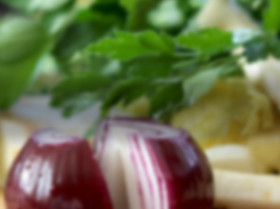Note from Amanda:
One of my favorite colleagues that I met through Twitter is a middle school physical educator Sarah Gietschier-Hartman @GHSaysRockChalk. Sarah and I don’t live far from each other, and so its been really awesome getting to know her and discussing all things #physed with her both in person and via Twitter.
Why do I admire Sarah so much?
Well, there are many reasons. I think that it’s a combination of her humility and vulnerability. Sarah epitomizes what all great teachers are - open to learning and growing, and not afraid to ask tough questions. I love how Sarah openly shares her evolved teaching practices and how she collaborates with others to continually hone her craft. It’s sooooo admirable. SO, if you didn’t yet pause in reading this post to follow her on Twitter, be sure to do so now. As well, Sarah is part of the @PHYSEDagogy team. So, while you are at it, give them a follow too.
Sarah’s assessment practices have really improved over the past couple years. She explains that more in her post below. When I first saw her analogy for Standards Based Grading (SBG) I was working on a provincial public health initiative around normalizing biking throughout society - for active transportation, fitness, sport, and social reasons. Moreover, I firmly believe that unless we (teachers, coaches, parents, decision makers, policy makers, builders) take a comprehensive approach to health and physical literacy we are going to swim upstream for many decades to come. Alas - I wondered - could this analogy continue to evolve in order to help shift the way our students view society?
Many of us grew up with food as a reward and activity as punishment - so messed up. I wondered, what if we used Sarah’s SBG approach as a way to increase students’ understanding toward healthy eating? Sarah, being Sarah, was so open to the conversation (this is a blog post in and of itself). Sarah knew I wasn’t criticizing her current practice - I was simply wondering if we could build on it to teach our students in a more comprehensive way. Again, Sarah being Sarah, emailed me pictures of her notes that night (her handwriting is off the hook by the way). I invited Sarah to share a bit about this process below. Can you offer your comments on how you might use this idea, or build upon it?
Before you go on to read Sarah’s post, I encourage you to look at Harvard’s Healthy Eating Plate and compare it to the US “My Plate” put out by the government. What are the similarities? Differences? Why do you think I like Harvard’s better?
 Sarah’s Guest Post
Sarah’s Guest Post
At the beginning of the 2013-14 school year, I decided to use a standards-based grading (SBG) system in my physical education classes. Before I made the switch to SBG, I assessed my students’ effort, participation, and ability to dress out. Now, I assess what my students know, understand, and can do in relation to specific outcomes.
I currently use four performance standards when assessing my students. They are:
E = Exceeds Standard = Wow!
S = Standard Met = Got it!
M = Making Progress = Getting there!
B = Basic Understanding = I can’t do this yet.
At some point in time on Twitter, I stumbled upon a cupcake analogy that could be used to explain SBG to students. To give you a taste (pun, totally intended) of the cupcake analogy, a Level 4 on an assessment is represented by a cupcake in a wrapper with icing and sprinkles. The cupcake, icing, and wrapper symbolize meeting the standard (or outcome) and the sprinkles (the Wow! factor) mean the student has exceeded the standard in some way.
I’ve used the cupcake analogy for two years with a ton of success. My students understand how they will be assessed in my classes. The analogy has been so successful that the other teachers in my building who use SBG use it now, too.
I know what you’re thinking. A #PhysEd teacher, who believes in teaching students to live a healthy and active lifestyle, which includes eating a healthy, well-balanced diet, is using cupcakes to explain her grading system to her students? There has to be something better! You’re absolutely right. You’re not the first person to challenge the cupcake analogy. Some of my Twitter followers gave me suggestions. A yogurt parfait, perhaps? A pizza with whole-grain crust? They just didn’t seem right to me. I stuck with the cupcakes.
But...what if the analogy didn’t just explain my grading system, but also taught the students how to create a plate of healthy food? That, my friends, is where Dr. Amanda Stanec (@movelivelearn) and the Healthy Eating Plate from Harvard Health Publications and the Harvard School of Public Health come into play. Amanda is a proponent for Harvard’s Healthy Eating Plate and reached out to me to discuss how my SBG system might be used to teach students about it. She wasn’t criticizing my current practice, Amanda was simply inviting us to have the conversation to see if it could serve our students a little better.
The Healthy Eating Plate can be used as guide for creating healthy, well-balanced meals. It is divided into six groups: vegetables, fruits, whole grains, healthy protein, healthy oils, and water. According to the Plate, we should:
- Eat whole grains and limit refined grains
- Choose fish, poultry, beans or nuts
- Limit red meat and avoid processed meat
- Eat an abundant variety of vegetables
- Avoid potatoes
- Choose a colorful variety of fruits
- Cook with olive and canola oils
- Limit butter and trans fat
- Drink water, tea, or coffee
- Limit milk/dairy to 1-2 servings per day
I’ve spent a lot of time thinking about how the Healthy Eating Plate could be used to explain my grading system to my students. I started sketching “incomplete” plates, which looked like uneven pie charts...meals with whole grains and healthy protein, but no fruits or veggies. I tried coming up with new, kid-friendly names for my performance standards. I tried figuring out what each performance standard would look like in a healthy or unhealthy plate form. Then it dawned on me...do all of my students even have access to the components of a healthy plate? Would a lesson about creating a well-balanced meal be engaging, appealing, and relatable for all of my students?
Let’s use this meal as an example: A leafy green salad with tomatoes, cucumbers, carrots, and broccoli, served with a healthy oil dressing; a fresh fruit salad with grapes, oranges, blueberries, and strawberries; a side of brown rice; a salmon or chicken filet; and a glass of water.
Many of my students have access to meals like this on a daily basis, but many of my students do not. Ok, Sarah, keep thinking. Which healthy foods do all of my students have access to? Aha! The food in the school cafeteria!
My students are responsible for the choices they make when purchasing food in the cafeteria. They have access to sandwiches and pizza, smoothies and salads, cookies and chips, fries and fresh fruit. What if my students used the school’s cafeteria menu to create examples of healthy meals they could choose at lunch? What if my students participated in meaningful discussions about what is important to include in a well-balanced meal? What if my students worked in small groups to determine which healthy (or unhealthy) plates could represent the four performance levels?
I may not be 100% certain on how the Healthy Plate will align with my SBG just yet, but I would love to hear your thoughts on how it help me normalize to students how healthy eating will bring them a plethora of rewards - related to both short- and long-term health.
So, team physed...what do you think?
Are you willing to give this a go?
How can you help a shift in the societal norms around food and activity that hinder our students’ development as physically and health literate people?





